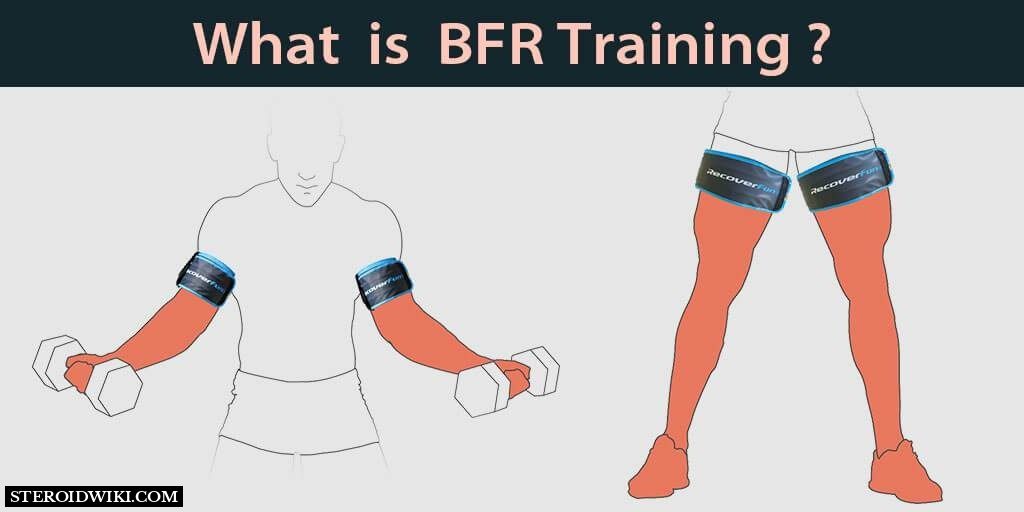What is Occlusion/BFR Training?
What is BFR Blood Flow Restriction exercise? How to perform BFR? What are the benefits of BFR?

BFR aka Blood Flow Restriction is a technique of working out in which a tension band is worn above the muscles to allow the blood flow from the heart to the muscles but restricting the blood flow that returns to the heart from the veins. The bands are usually worn between the biceps and the shoulders to restrict the blood to the biceps and triceps or above the upper thigh to restrict the blood from the thigh. This allows acids and metabolites to be trapped in the muscle and increases muscle mass.
BFR is also known as Occlusion Training, Hypoxic training, or Kaatsu in Japanese.
This method of exercise began in Japan in the sixties, where Dr. Yoshiaki Sato was in a Buddhist ceremony and was sitting in a way that confined blood to the calf muscle, causing a burning sensation. He notices this to be similar to the burning that was felt during resistance exercises, so he tried to tie his upper muscles to mimic the same effect of Burning and noticed an increase in the muscle mass.
The restriction is done by attaching a ligament with limited intensity so that it does not greatly reduce the arterial blood flow that enters the muscle, but reduces the venous blood that exits from the muscles to the heart. This reduces the amount of oxygen in the muscles (that's why it is called Hypoxic Training because it reduces oxygen). This focuses the work on the anaerobic muscle Fast Twitch Type II and reduces the work of the aerobic muscle Slow Twitch Type I. It also increases the blocking of metabolic substances in the muscle such as Myokines and Lactic Acid, which gives a burning feeling in the last iterations of the repititions.
When the lactate acid increases in the muscle, the body increases the secretion of growth hormone and your Central Nervous System (CNS) starts to run the fast-twitching type II muscle as fast as possible. Also, lactate acid increases fluid in muscle cells, causing them to swell, so the cells sense the danger of bloating and begin to change their composition thus increasing muscle protein synthesis.
In other words, this method of exercise maximizes the metabolic stress in the muscles, which is one of the three mechanisms of muscle growth. The other two methods are the Mechanical Tension and the Muscle Damage. The Mechanical Tension is lifting of heavy weights with a full range of motion to put the muscle under tension/pressure. And the Muscle Damage is a laceration event in the muscle fibers, which occurs from Concentric Repetition.
What weights can i lift during BFR?
The exercises are performed with very light weights, 40% of the 1RM, which means 40% of the maximum weight you can move for one repetition. Let's say half of the weights you lift for ease of explanation. If you want to calculate the 1RM of each exercise, you can use the 1RM Calculator .
I mean, if you lift 40kg in a biceps workout with a barbell, you will lift 20kg with the strapping (an empty Olympic bar weight).
There is scientific research that compared the weights lifted in BFR exercises with blood restriction between 20%, 30% and 40% of the 1RM, and found that the maximum activation of the Fast Twitch muscles occurs while lifting 40% of the 1RM.
Another research found that there was no difference in muscle contraction between 40% and 80% of the 1RM with BFR exercises, and that raising 80% of the 1RM during exercise reduces the metabolic stress.
For this reason, 40% of the 1RM is what is recommended, which is why the BFR exercise is very popular in the physiotherapy community to rehabilitate patients, and is excellent for those who have a chronic injury to one of their joints and for the elderly.
How to use the straps?
You can buy a BFR straps on Amazon, or use a knee strap on top of the muscle towards the heart. Such as over the biceps, and over the calves and over the thigh. See the image below.

The tension is kept with a strength of 7 out of 10, as 1 is no pressure at all and 10 is the tightest binding that causes you to experience numbness and tingling in your limbs.
Scientific research has found that tension by more than 7 reduces the blood flow in the artery to the muscle, which reduces the effectiveness of exercise. What you need is to block the venous blood going from the muscle to the heart, and not block the arterial blood flow entering from the heart to the muscle.
If you considervthe binding intensity of 7 to be alot, there is a scientific research that found that the binding intensity of 4 or 8 have the same effect on muscle growth and exercise effectiveness. Therefore if you are not confident in what is the intensity of 7, it is better that the binding be lighter than more severe than what is required. Better to be too loose than too tight.
The strapping takes place in an area of 5-9 cm. If you use the knee strap, do not tie it in a spiral form, but tie it in layers on top of each other so that it does not exceed an area of 9 cm.
If the ligation is performed in an area greater than 13 cm, arterial blood flow is blocked and the effectiveness of the exercise is reduced.
How to perform the exercises?
The exercise is done by lifting with high repetitions 15-30 repetitions, because the weight is 40% of the 1RM, with short rest periods to allow the accumulation of as much lactic acid as possible. Therefore, the best way is to do a super set between the biceps and triceps or between the back thigh and the front thigh (super set between leg curls and leg extensions), at the end of your training session.
I mean, whatever your training program is for muscle mass or strength, you do 3-4 rounds of supersets of isolation exercises for the biceps and triceps, or 3-4 rounds of supersets for the front thigh and hind thigh such as the front leg swing and the rear leg swing. If you have healthy joints and want to incorporate this technique into your program, it is better to make it the last exercise in your regimen.
And since scientific research has found that BFR exercise does not cause fatigue or difficulty in recovery, the BFR is an excellent method of exercise during deloading weeks.
Does BFR work for limbs only?
You talked about connecting the upper biceps, upper thigh and upper calf, but what about other muscles such as chest, back, shoulders and butt?
Yes, the muscles of the entire body benefit if they are tied at the joints only. There is scientific research that binding the arm during the bench press with a light weight, increases the work of the chest muscles by 16%. This phenomena is called the Cross Transfer Effect, as your central nervous system senses severe stress in your arm during the bench press, and it compensates for this stress by operating the chest muscle more to lift the weight.
There is also another explanation that your blood becomes rich in metabolic materials and growth factors, so all the muscles in your body benefit from the BFR Technique.
In a scientific research it was found that the trainees who exercise their arm after exercising the legs with the BFR method, got more muscle growth in the arm!
Is BFR Blood Flow Restriction safe?
A 2014 scientific review found that in the long run, blood-containing exercise does not cause muscle damage, reduce strength or impair muscle function. The review also found that the muscle pain (DOMS) that occurs from blood-tightening exercises is to the same degree as the pain that occurs from traditional barbell exercises without ligation.
If you are not used to exercising with high repetitions, it is better to start BFR exercises once or twice a week at most, until you get used to it.
There was a theory that blood restriction exercises caused a narrowing and obstruction in the blood flow in the veins due to the ligation, but there is scientific research that found that after BFR exercises in 4 weeks increased the expansion of blood vessels and blood flow in them, more than what was achieved by the traditional iron exercises!
BFR for tendon strengthening?
In a scientific research published in December 2019, the volunteers were divided into two groups, one group performed iron exercises with a heavy weight of 75% of the 1RM and increased the weights over a period of 4 weeks up to 85% of the 1RM. Whereas the other group performed the BFR exercises with an intensity of 20% of the 1RM and increased it over 4 weeks up to 35% of the volunteer's 1RM.
The scientists noticed that the two groups increased the strength and muscle mass to the same degree, and the thickness and strength of the tendon increased to the same degree as well! I mean, BFR exercises are not only beneficial for the muscles, but also for the strength of the tendons! This makes Blood Flow Restriction an excellent tool for rehabilitation of patients in physiotherapy clinics.




















